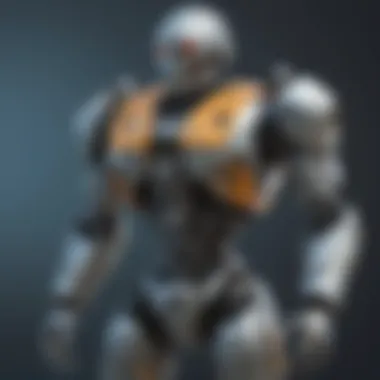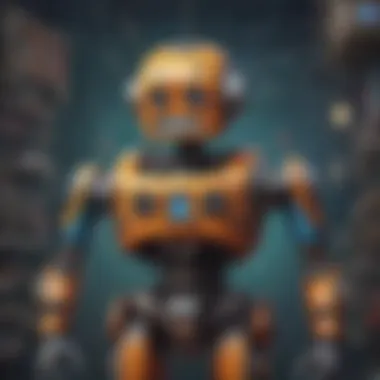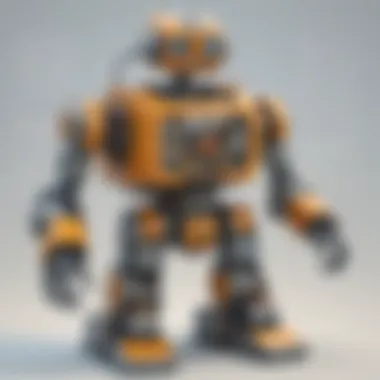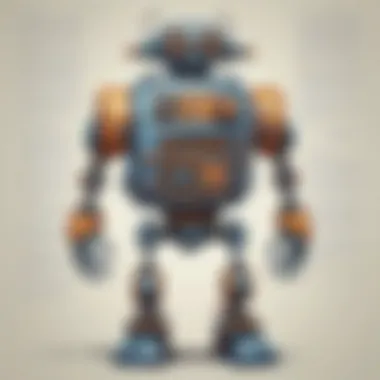Unleash Your Creativity: A Guide to Designing Your Own Robot


Science Fun Facts
Let's embark on an exciting journey into the world of robotics with some intriguing science fun facts! Did you know that the first industrial robot, Unimate, was introduced in 1961 by George Devol and Joseph Engelberger? It revolutionized the manufacturing industry and paved the way for modern robotics. Another fascinating fact is that robots are used not only on Earth but also in space exploration! They help scientists collect data in extreme environments where humans cannot easily reach. These fun facts highlight the innovative and diverse uses of robots in our world.
Discover the Wonders of Science
As young science enthusiasts, uncovering the wonders of science is an exhilarating adventure. By delving into various scientific concepts, you can understand how robots are designed and programmed based on principles of engineering and technology. Explore educational videos and animations that showcase the evolution of robotics, from the early mechanical automatons to the sophisticated AI-powered robots of today. Discover real-life applications of science through interactive learning tools that demonstrate how robotic automation is shaping industries like healthcare, manufacturing, and even household chores.
Science Quiz Time
Engage your curious minds with interactive quizzes focusing on robotics and technology. Test your knowledge with multiple-choice questions that challenge you to think critically and problem-solve. Dive into brain teasers and puzzles that stimulate your creativity and logical thinking skills. Learning through gamification makes the process fun and engaging, bridging theoretical knowledge with practical applications. Explore how robots move, perceive their environment, and interact with humans through immersive quiz experiences that enhance your understanding of robotic principles.
Science Experiment Showcase
Unleash your creativity with fun and engaging experiments that bring robotics to life. Follow step-by-step instructions to build simple robots using everyday materials like cardboard, motors, and sensors. Create a materials list to gather all the necessary components for your robotics projects. Prioritize safety tips and precautions to ensure a secure and enjoyable experimentation process. From building a basic motorized robot to designing a sensor-powered rover, these hands-on experiments provide a hands-on understanding of robotics principles in action.
Introduction
In the realm of robotics, there lies a universe of possibilities waiting to be explored by young minds. The essence of this article lies in unveiling the fundamentals of designing a robot, tailored specifically for young science enthusiasts between the ages of 6 to 12. By embarking on this creative journey, children are not only exposed to the captivating world of robotics but also encouraged to cultivate crucial skills like problem-solving and innovation. Through this guide, young readers are poised to delve into a realm where imagination meets technology, sparking a passion for invention and ingenuity.
Understanding Robots
Defining robots
Robots, in their essence, are mechanical wonders designed to execute tasks autonomously or semi-autonomously. In the context of this guide, the term 'Defining robots' serves as a gateway to conceptualizing the core functionalities of these mechanical entities. By understanding the intricacies of what makes a robot, children can grasp the concept of automation and its applications in various spheres. The unique feature of 'Defining robots' lies in their ability to streamline complex processes efficiently, making them a valuable asset in the landscape of this article.
Exploring robotic applications
'Discovering robotic applications' broadens the horizons of young enthusiasts by showcasing the diverse fields where robotics plays a pivotal role. From manufacturing to healthcare and beyond, robots are instrumental in simplifying tasks and enhancing efficiency. By exploring the vast applications of robotics, children gain insight into how technology intersects with everyday life, igniting a curiosity to innovate and problem-solve creatively. The feature that sets 'Exploring robotic applications' apart is its practical relevance, offering a tangible connection between theoretical knowledge and real-world implementation.
The evolution of robotics
The evolution of robotics encapsulates the transformative journey of these mechanical marvels from antiquity to the modern era. Understanding 'The evolution of robotics' enables young learners to appreciate the advancements that have shaped this field, setting the stage for future innovation. By tracing the development of robotics, children are inspired to envision the possibilities for technological growth and adaptability. The striking feature of 'The evolution of robotics' is its narrative of progress, underscoring how each iteration of technology builds upon the foundation laid by its predecessors.
Benefits of Building Your Own Robot
Enhancing creativity
'Boosting creativity' is a fundamental aspect of constructing one's robot, as it encourages young minds to think divergently and unleash their imagination. By engaging in the creation process, children imbue their robot with unique traits, fostering a sense of ownership and creativity. The standout feature of 'Amplifying creativity' is its potential to nurture innovative thinking and artistic expression, instilling a sense of pride and accomplishment in young inventors.
Developing problem-solving skills
Navigating the complexities of building a robot cultivates problem-solving skills among young enthusiasts, equipping them with the ability to troubleshoot and iterate. 'Cultivating problem-solving skills' empowers children to overcome obstacles methodically, honing their analytical prowess and resilience. The defining trait of 'Developing problem-solving skills' lies in its practical applicability, preparing young learners to tackle challenges with confidence and creativity.
Encouraging innovation
Fostering a culture of innovation is integral to the process of building a robot, as it inspires young inventors to push the boundaries of conventional thinking. 'Promoting innovation' emboldens children to experiment, take risks, and explore new possibilities in their robot designs. The standout aspect of 'Spurring innovation' is its capacity to fuel curiosity and drive, instilling a thirst for exploration and discovery in budding engineers.
Getting Started


In the realm of building your own robot, the journey of creation commences with Getting Started, a pivotal phase laying the groundwork for the entire project. Choosing this initial step thoughtfully is crucial as it sets the tone for the creative process ahead. Getting Started involves delving into the essentials of conceptualization, planning, and organizing, forming the backbone of your robot-building endeavor.
Choosing Your Design
Researching different robot types
When embarking on the path of designing your robotic creation, delving into the realm of Researching different robot types plays a vital role. The exploration of various robot classifications and functionalities enriches your understanding, assisting in the selection of the most suitable design for your project. By identifying the unique characteristics and applications of diverse robot types, you can make informed decisions to align your vision with the optimal robotic framework.
Brainstorming design ideas
As you venture into the creative process of robot design, the stage of Brainstorming design ideas emerges as a pivotal facet. This phase encourages innovative thinking, fostering a space for imaginative ideation and concept development. Through brainstorming sessions, you harness the power of creativity to generate novel design elements, infusing personality and uniqueness into your robotic creation.
Considering functionality
In the process of designing a robot, Considering functionality becomes a fundamental consideration. This aspect emphasizes the integration of functionalities that serve specific purposes and enhance the overall performance of your robot. By assessing the intended use and capabilities of your robot, you can tailor its functionality to align with your targeted objectives, ensuring an efficient and purposeful end product.
Materials and Tools
List of required materials
When setting out on your robot-building journey, compiling a comprehensive List of required materials is indispensable. This meticulous cataloging of materials ensures you have all the necessary components at hand, streamlining the construction process and avoiding delays. By detailing each item needed for your robot project, you create a robust foundation for smooth progression and successful completion.
Essential tools for building
Equipping yourself with the Essential tools for building is essential for executing your robotic design with precision and finesse. The selection of appropriate tools, tailored to the intricacies of robot construction, enhances efficiency and accuracy in assembly. By leveraging specialized tools designed for robotics projects, you optimize the craftsmanship of your creation, achieving a high standard of quality and functionality.
Safety precautions
Prioritizing safety measures throughout your robot-building endeavor is paramount, underlined by the emphasis on Safety precautions. Implementing stringent safety protocols and practices safeguards against potential hazards, ensuring a secure working environment. By adhering to safety guidelines and precautions, you mitigate risks and promote a secure and controlled setting for uninterrupted progress.
Setting Up Your Workspace
Organizing workspace
Establishing an efficient workspace layout is instrumental in the preparatory phase of robot construction, emphasizing the significance of Organizing workspace. A well-organized workspace enhances productivity and workflow efficiency, facilitating seamless movement and access to tools and materials. By optimizing the layout of your workspace, you create a conducive environment for focused and streamlined work processes.
Creating a plan
Creating a systematic plan for your robot-building project is a strategic step that propels you towards successful completion. The process of Creating a plan involves outlining the project scope, timeline, and tasks, providing a roadmap for structured execution. By formulating a detailed plan, you establish a clear direction for your project, enabling efficient task management and goal attainment.
Gathering supplies
The process of Gathering supplies encompasses collecting all necessary components and resources essential for your robot construction. This meticulous gathering of supplies ensures you have easy access to required materials, minimizing disruptions during assembly. By procuring all relevant supplies in advance, you create a well-prepared environment that fosters uninterrupted progress and seamless execution of your robot-building endeavor.
Design and Construction
When delving into the realm of robotics, the design and construction phase plays a pivotal role in bringing your creation to life. This section guides young science enthusiasts on the journey of conceptualizing and building their robot from scratch, emphasizing the skill development and creativity involved in the process. Understanding the importance of design and construction sets the foundation for a successful robotics project. It encourages critical thinking, problem-solving, and hands-on learning, essential skills for young minds to nurture.
Creating a Blueprint


Sketching your robot design
In the process of sketching a robot design, children get to visualize and plan how their robot will look and function. This creative task allows them to explore different shapes, sizes, and features, enhancing their imagination and attention to detail. Sketching not only serves as a visual representation of the final product but also acts as a roadmap, guiding the construction process efficiently. It helps young enthusiasts translate their ideas into tangible designs, promoting precision and innovation.
Planning functionality
Planning the functionality of the robot involves detailing how each component will work together to achieve the desired tasks. By considering aspects like movement, sensors, and interaction capabilities, young designers learn to think systematically and problem-solve proactively. This stage prompts children to analyze the purpose of their robot and tailor its functions accordingly, fostering critical decision-making skills and strategic thinking.
Incorporating unique features
Integrating unique features into the robot design adds a personalized touch and showcases the creator's innovation. Whether it's a special sensor, a distinctive motion mechanism, or a creative aesthetic element, incorporating uniqueness enhances the overall appeal and functionality of the robot. Encouraging young enthusiasts to think outside the box and experiment with novel ideas, this aspect of robot creation empowers them to express their individuality and creativity.
Assembling Your Robot
Step-by-step construction process
The step-by-step construction process breaks down the building journey into manageable tasks, allowing young designers to progress methodically. Following a systematic approach instills discipline and organization, reinforcing the importance of order and structure in projects. Each step offers a learning opportunity, where children build practical skills such as precision, patience, and attention to detail. By following a structured process, aspiring inventors gain confidence in their abilities and see their robot come to life gradually.
Testing mechanisms
Testing mechanisms involves checking the functionality and performance of each component within the robot. Through testing, young creators verify if their design aligns with the intended functionalities and identify any areas for improvement. This hands-on experimentation instills scientific inquiry and problem-solving skills, as children analyze results, make adjustments, and optimize their robot's capabilities. Testing not only ensures the quality of the robot but also encourages a mindset of continuous learning and refinement.
Troubleshooting
Troubleshooting is an essential skill that prepares young designers to address challenges and setbacks during the construction process. Encountering issues like connectivity problems, mechanical errors, or programming bugs is common in robotics projects. The ability to troubleshoot effectively promotes resilience, adaptability, and critical thinking, crucial attributes for overcoming obstacles. By navigating through troubleshooting scenarios, children develop a problem-solving mindset, resilience, and determination to persevere until their robot functions seamlessly.
Programming and Testing
In the realm of designing your own robot, the significance of programming and testing cannot be overstated. This section delves into the fundamental aspects of programming your robot to perform specific tasks and the crucial testing phase to ensure optimal functionality and performance efficiency. Programming serves as the brain of the robot, dictating its actions and responses to external stimuli, making it a pivotal element in the robot's functionality. Testing, on the other hand, is the phase where the robot's capabilities and mechanisms are put to the test, identifying potential issues and refining its operations.
Introduction to Programming
Basic programming concepts
Basic programming concepts form the cornerstone of robot control and autonomy. These concepts encompass fundamental commands and logic structures that define how the robot interprets instructions and executes tasks. Understanding these concepts is essential for young enthusiasts to grasp the essence of programming their robots effectively. Concepts such as variables, loops, and conditional statements provide the building blocks for creating intricate robotic behaviors. The simplicity yet robustness of basic programming concepts makes them a popular choice for beginners, allowing for gradual skill development and logical reasoning enhancement. While these concepts offer a straightforward approach to programming, their versatility and applicability in various robotic functionalities make them indispensable in this article.
Choosing a programming language
Selecting the appropriate programming language is pivotal in shaping the robot's capabilities and the ease of programming. Each programming language comes with its syntax, rules, and functionalities, influencing how commands are structured and executed. Information on different programming languages such as Python, C++, or Scratch will guide young aspirants in making informed decisions based on their project requirements and familiarity. The ability of a programming language to simplify complex operations or enable advanced functions can significantly impact the robot-building process, making the choice of language a critical consideration in this article.
Writing commands
Writing commands is the practical application of programming concepts to direct the robot's actions and behaviors. Commands serve as directives that instruct the robot on tasks to perform, movements to execute, or sensors to activate. The precision and clarity in writing commands ensure that the robot interprets instructions accurately, translating them into real-world actions seamlessly. Creating concise and effective commands is vital in programming, as it determines the efficiency and accuracy of the robot's responses. Understanding how to structure commands correctly and optimize their impact on robot behavior empowers young enthusiasts to harness the full potential of their creations in this article.
Testing Your Robot
Calibrating sensors
Calibrating sensors plays a vital role in ensuring the accuracy and reliability of sensor data used in decision-making processes. This meticulous process involves adjusting sensor settings to match expected values, minimizing discrepancies and inaccuracies in sensor readings. By calibrating sensors meticulously, young robot builders can enhance the precision of their robot's interactions with the environment, enabling more refined actions and responses. The ability to calibrate sensors effectively is crucial for optimizing the robot's performance and capabilities, making it a key focus area in this article.


Running diagnostic tests
Running diagnostic tests involves evaluating the internal systems and components of the robot to identify potential malfunctions or inefficiencies. By conducting systematic diagnostic procedures, builders can pinpoint issues affecting the robot's performance and address them promptly. Diagnostic tests help in validating the functionality of motors, sensors, and communication modules, ensuring seamless integration and operation. The systematic approach to running tests enables young enthusiasts to troubleshoot effectively and enhance their problem-solving skills as they refine their robots for optimal performance in this article.
Evaluating performance
Evaluating the performance of the robot is essential in gauging its operational efficiency and effectiveness in meeting set objectives. This evaluation encompasses assessing the robot's speed, accuracy, and responsiveness to commands, offering insights into areas that require improvement or fine-tuning. By systematically evaluating performance metrics, young builders can iteratively enhance their robot's capabilities, pushing the boundaries of creativity and innovation. The process of evaluating performance serves as a feedback mechanism for young enthusiasts, guiding them towards refining their robot designs and functionalities to achieve optimal results in this article.
Customization and Personalization
Customization and Personalization play a crucial role in the process of designing your own robot in this creative guide for young science enthusiasts. The ability to add personal touches, unique features, and customize functionality enhances the overall experience for the young creators. By allowing them to imprint their individuality on their creations, customization and personalization not only foster a sense of ownership but also boost creative thinking and problem-solving skills. Considering color schemes, design elements, and specific functionalities tailored to their preferences empowers young enthusiasts to explore their creativity and innovation.
Decorating your robot
Decorating your robot is a pivotal aspect of personalization, as it adds a personalized flair to the robot's appearance. By choosing specific color palettes, textures, and patterns, young creators can express their personalities through visual aesthetics. Decorating the robot not only enhances its visual appeal but also enables the creator to communicate a particular theme or message through design choices. The detailed adornment of the robot creates a unique identity for the creation, making it stand out and fostering a sense of pride and accomplishment in the young designer. While decorating your robot can be time-consuming, the process offers a valuable opportunity for young enthusiasts to explore their artistic sensibilities and attention to detail.
Incorporating unique features
Incorporating unique features into the robot design adds a layer of innovation and functionality to the creation. By integrating unconventional elements or mechanisms, young inventors can enhance the robot's capabilities and performance. Unique features can include specialized sensors, modular components, or interactive gadgets that set the robot apart from conventional designs. The incorporation of distinctive features not only elevates the robot's functionality but also challenges young enthusiasts to think outside the box and push the boundaries of traditional robotics. While implementing unique features may require additional planning and experimentation, the outcome can result in a truly one-of-a-kind robot that showcases the creativity and technical skills of its designer.
Customizing functionality
Customizing functionality allows young creators to tailor the robot's capabilities to specific tasks or challenges. By adjusting programming commands, sensor settings, or mechanical configurations, aspiring inventors can optimize the robot for various purposes. Customizing functionality enables the robot to perform specialized actions or exhibit specific behaviors based on the creator's intentions. This hands-on approach to customization not only sharpens problem-solving skills but also instills a deeper understanding of robotics principles. The process of customizing functionality requires careful consideration of the desired outcomes and may involve iterative testing and refinement to achieve optimal performance. Through this process, young enthusiasts gain valuable insights into robotics engineering and develop the ability to adapt technology to meet unique needs.
Showcasing Your Creation
Showcasing Your Creation is a pivotal step in the journey of designing your own robot, culminating in the presentation and demonstration of the innovative work. It involves preparing the robot for display, demonstrating its capabilities, and sharing the creation with others to inspire and engage audiences. Showcasing not only highlights the hard work and creativity invested in the robot but also provides a platform for young designers to receive feedback and recognition for their achievements.
Preparing for presentation
Preparing the robot for presentation involves setting up the display area, organizing supplementary materials, and ensuring the robot is in optimal condition for demonstration. By arranging the robot in an aesthetically pleasing manner, creating informative posters or visuals, and rehearsing the presentation, young creators can effectively communicate the robot's design and functionality to viewers. The preparation process allows the designer to showcase the robot in its best light, captivating the audience's attention and sparking curiosity about the project. While preparing for presentation demands meticulous attention to detail, it offers valuable experience in event planning, public speaking, and graphic design for young science enthusiasts.
Demonstrating capabilities
Demonstrating the robot's capabilities involves showcasing its features, performance, and functionalities through interactive demonstrations or simulations. By operating the robot in various scenarios, performing specific tasks, and highlighting unique functions, young creators can illustrate the potential and versatility of their creation. Demonstrating capabilities not only validates the robot's design and construction but also provides insights into its practical applications and real-world value. Engaging in hands-on demonstrations allows young inventors to refine their presentation skills, problem-solving abilities, and technical knowledge, enhancing their overall experience in robotics.
Sharing with others
Sharing the robot with others is a significant aspect of showcasing your creation, as it enables young designers to inspire and educate a broader audience. By presenting the robot to peers, family members, teachers, or fellow enthusiasts, creators can receive valuable feedback, appreciation, and encouragement for their work. Sharing the robot can spark interest in robotics among others, foster collaborative projects, and create a supportive community of like-minded individuals. The act of sharing personal achievements promotes mutual learning, creativity, and enthusiasm for science and technology, contributing to a culture of innovation and exploration among young science enthusiasts.
Conclusion
In the final section of this informative guide on designing your own robot for young science enthusiasts, we unravel the significance of the journey taken thus far. The conclusion serves as a pivotal point around which the entirety of the article converges, tying together the essence of creativity, problem-solving, and innovation that are fundamental to the world of robotics. It acts as a culmination of the steps outlined in the previous sections, providing a platform for reflection on the meticulous process of crafting a personalized robot. Emphasizing the importance of perseverance, attention to detail, and the joy of creation, the conclusion encourages young minds to continue exploring the fascinating realm of robotics with a newfound zeal.
Future Explorations
Continued learning in robotics
Considering the vast expanse of knowledge and skills in the field of robotics, continued learning plays a vital role in nurturing the young inventors' curiosity and expertise. Delving deeper into concepts such as coding, circuitry, and mechanical design allows for a more profound understanding of robot construction. By engaging in continuous learning, aspiring roboticists enhance their problem-solving abilities, critical thinking skills, and grasp of advanced robotics principles. The allure of endless possibilities in robotics exploration propels young enthusiasts towards a path of continuous growth and development.
Exploring advanced concepts
Exploring advanced concepts in robotics offers a gateway to a realm where creativity meets technology. By venturing into complex topics like artificial intelligence, machine learning, and autonomous navigation, young learners expand their intellectual horizons and challenge themselves to think innovatively. Such exploration not only broadens their knowledge base but also equips them with the foresight to conceptualize groundbreaking robotic creations. The pursuit of advanced concepts in robotics fosters a spirit of ingenuity and pushes young enthusiasts to reach new heights in their inventiveness.
Inspiring others
Inspiring others through the captivating world of robotics is a noble endeavor that nurtures a culture of innovation and shared learning. By showcasing their robot creations, young inventors not only demonstrate their technical skills but also ignite the spark of curiosity in their peers and broader communities. The act of inspiring others fosters collaboration, creativity, and mutual encouragement, creating a ripple effect of ingenuity and aspiration within the realms of young scientists and inventors. Through the exchange of ideas and inspiration, young enthusiasts pave the way for a future generation of innovators, leaving a lasting impact on the world of robotics.







